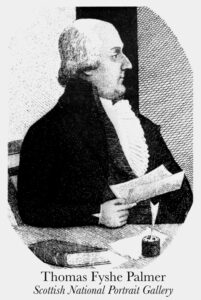 Thomas Fyshe Palmer (July 1747-June 2, 1802) was one of five, eighteenth-century British political reformers, who came to be known as “The Scottish Martyrs”. Palmer was born in England, educated at Cambridge University, and ordained to the Anglican clergy before falling under the influence of Joseph Priestley. He embraced Unitarian beliefs and moved to Scotland where he ministered to Unitarian churches and agitated for universal suffrage. Convicted of sedition in 1793, he was sentenced to seven years in Australia, which at the time served as the United Kingdom’s penal colony.
Thomas Fyshe Palmer (July 1747-June 2, 1802) was one of five, eighteenth-century British political reformers, who came to be known as “The Scottish Martyrs”. Palmer was born in England, educated at Cambridge University, and ordained to the Anglican clergy before falling under the influence of Joseph Priestley. He embraced Unitarian beliefs and moved to Scotland where he ministered to Unitarian churches and agitated for universal suffrage. Convicted of sedition in 1793, he was sentenced to seven years in Australia, which at the time served as the United Kingdom’s penal colony.
Palmer was born into a well off family in Northill, Bedfordshire, England. After attending Eton, he was admitted to Cambridge University. He graduated BA 1769, MA 1772 and BD 1781. In 1781 he was elected a Fellow of Queen’s College, Cambridge, at the age of 34. Ordained an Anglican clergyman, Palmer was appointed curate at Leatherhead, Surry.
In the Cambridge of his day there was much Biblical textural criticism and Joseph Priestley, the famous Unitarian minister and scientist was at the height of his influence. Priestley’s Unitarian publications strongly influenced Palmer and he decided he could no longer be an Anglican. At this time he made contact with Priestley’s friend Theophilus Lindsey who had also left the Anglican Church. Palmer, writing as Anglo-Scotus, wrote a number of articles for the Theological Repository, a journal founded and edited by Joseph Priestley. In adopting Unitarianism Palmer gave up both his excellent prospects in the Church of England and an academic career as he had to resign his Fellowship at Cambridge.
Through Theophilus Lindsey he heard of the Montrose Unitarian Society in Scotland. Founded by William Christie and others it is said to have been the first Unitarian church in Scotland. Palmer went to Montrose as its first minister in 1783. He moved on to Dundee, Scotland in 1785. He published religious tracts and later, after the French Revolution broke out in 1789, he published political tracts calling for democracy and universal [male] suffrage. A political society formed, The Friends of Liberty, and Thomas Paine’s book The Rights of Man was circulated. Dundee, Scotland was a major center of Scottish political ferment and the authorities were determined to stamp it out.
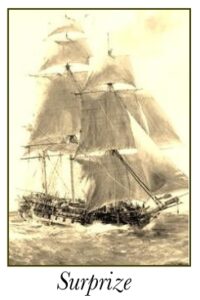 In September 1793 Palmer appeared in court charged with sedition. After a shoddy trial, with poor prosecution evidence, he was found guilty and sentenced to seven years transportation to the penal colony at Botany Bay, New South Wales, Australia. Four others were convicted of sedition and sentenced to 14 years transportation. Palmer had been convicted under an ancient Scottish law. He would not have been charged in England where the sedition laws were not so broad. Efforts to revise the Scottish sedition law were made in Parliament. In 1794 the Earl of Lauderdale and Earl Stanhope in the House of Lords along with Fox and Sheridan in the House of Commons sought to release Palmer and Thomas Muir before they could be transported. That effort failed and Palmer was confined on the prison ship Stanislaus near Woolwich on the Thames River for three months before being transferred to the transport vessel Surprize. Parliamentary efforts failed and three months later, in May 1794, the fleet left England on the six month journey to Australia.
In September 1793 Palmer appeared in court charged with sedition. After a shoddy trial, with poor prosecution evidence, he was found guilty and sentenced to seven years transportation to the penal colony at Botany Bay, New South Wales, Australia. Four others were convicted of sedition and sentenced to 14 years transportation. Palmer had been convicted under an ancient Scottish law. He would not have been charged in England where the sedition laws were not so broad. Efforts to revise the Scottish sedition law were made in Parliament. In 1794 the Earl of Lauderdale and Earl Stanhope in the House of Lords along with Fox and Sheridan in the House of Commons sought to release Palmer and Thomas Muir before they could be transported. That effort failed and Palmer was confined on the prison ship Stanislaus near Woolwich on the Thames River for three months before being transferred to the transport vessel Surprize. Parliamentary efforts failed and three months later, in May 1794, the fleet left England on the six month journey to Australia.
Four of the five Scottish Martyrs were transported in the convict ship Surprise (or Surprize). A ‘domestick’ companion, James Ellis, was allowed to accompany Palmer as a free settler to the colony. A month after setting sail, the captain of the Surprize accused Palmer and William Skirving of conspiring to commandeer the ship and sail to France or America. Both were confined under armed guard for the rest of the trip. Both the captain and the martyrs sent dispatches back to England during a one-month layover in Rio de Janeiro. Once they landed in the six-year-old settlement of Sydney, both sides pled their case with Lieutenant-Governor Grose. Palmer wrote, A Narrative of the Sufferings of T.F. Palmer, and W. Skirving, during a voyage to New South Wales, 1794, on board the Surprise transport. It was published in England in 1797. In the end, the conspiracy or mutiny charges were not pressed and they faded away.
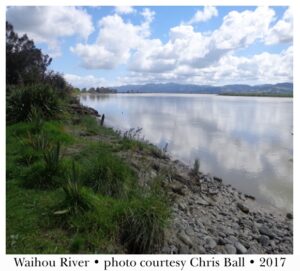 Palmer adapted well to his new Australian life, he wrote to Unitarian friends in England describing Australia as a wonderful country, with marvelous birds and plants and a great climate. When the Governor found that Palmer and the other political prisoners were prepared to be cooperative he allowed them privileges. Palmer received books and papers from his Unitarian friends back home. Palmer and the others set about trying to make their fortunes. They bought farms for themselves and were allowed to use convict labor. In addition they began brewing and ran a profitable rum trade to Norfolk Island, reports of which shocked some Unitarian friends in England.
Palmer adapted well to his new Australian life, he wrote to Unitarian friends in England describing Australia as a wonderful country, with marvelous birds and plants and a great climate. When the Governor found that Palmer and the other political prisoners were prepared to be cooperative he allowed them privileges. Palmer received books and papers from his Unitarian friends back home. Palmer and the others set about trying to make their fortunes. They bought farms for themselves and were allowed to use convict labor. In addition they began brewing and ran a profitable rum trade to Norfolk Island, reports of which shocked some Unitarian friends in England.
When Palmer had completed his sentence in September 1800 he and his friends bought a Spanish prize of war the El Plumier, (also known as the Plomer) which they sailed on 5 January 1801 from Sydney for New Zealand intending to obtain a cargo of timber. They reached the Waihou River at the southern end of the Hauraki Gulf (which would later be known as the Firth of Thames) on 2 March but their ship was damaged and they were effectively stranded until the Royal Admiral came to their rescue. (The Royal Admiral was a fine East Indiaman merchant ship three times the tonnage of James Cook’s Endeavour).
It had been thirty years since Captain James Cook, the famous 18th century English explorer had navigated New Zealand and produced the first map of its coastline. Cook and some crew also explored the Waihou River. At its mouth they found “a very fine river broad as the Thames at Greenwich [in England] tho not quite so deep.” This was Cook’s only inland journey within New Zealand and they spent two days discovering the extent of one of New Zealand’s longest rivers. They found “the banks of the river were completely clothed with the finest timber [their] eyes ever beheld.” Palmer and the El Plumier crew stayed on the Waihou River for six months without much success. They were looking to acquire timber to make their voyage financially viable while they repaired their ship. After some strife with the local Maori and sickness amongst the crew, the El Plumier set sail again on 20 August 1801.These were the problematic circumstances that accompanied the first recorded visit of a Unitarian minister to New Zealand.
On 12 January 1802 they reached Guam where their ship was taken as a war prize by the authorities and the crew became prisoners of the Spanish Governor. Palmer died there, probably in June of dysentery. His companion James Ellis was appointed as executor. When Ellis died at Manila in 1805 he left his property to his sisters in Dundee, Scotland.
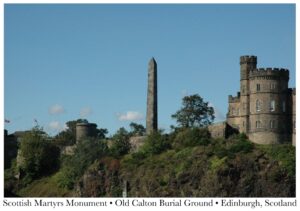 The Spanish priests would not allow Palmer to be buried in consecrated ground because he was a heretic so he was buried by the seashore among pirates. From there in May 1804 an American ship’s captain Samuel W. Balch, took his remains to Boston, Massachusetts for burial. Since Palmer had been ordained in the Church of England his remains were placed in a vault at Trinity Church in Boston. The service was performed by Rev. Gardiner, Trinity’s rector on 2 February 1810. There are no longer any traces of the vault location or the inscribed marble tablet.
The Spanish priests would not allow Palmer to be buried in consecrated ground because he was a heretic so he was buried by the seashore among pirates. From there in May 1804 an American ship’s captain Samuel W. Balch, took his remains to Boston, Massachusetts for burial. Since Palmer had been ordained in the Church of England his remains were placed in a vault at Trinity Church in Boston. The service was performed by Rev. Gardiner, Trinity’s rector on 2 February 1810. There are no longer any traces of the vault location or the inscribed marble tablet.
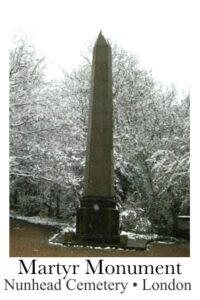 The Scottish Martyrs were not forgotten. Starting at a public meeting in 1837, radical MP Joseph Hume raised funds from the public to build a monument to them. Hume’s workmen started building it in London where Oxford Street crossed Regent Street but this was soon stopped by local commissioners. In the end, two monuments were built. Hume laid the foundation stone for the first one in 1844 in the Calton Hill burial ground in Edinburgh, Scotland. That monument is 27.4m (90 feet) in height and is dedicated, “To The Memory Of Thomas Muir, Thomas Fyshe Palmer, William Skirving, Maurice Margarot, and Joseph Gerrald.” Another panel says it was “Erected by the Friends of Parliamentary Reform in England and Scotland, 1844.”
The Scottish Martyrs were not forgotten. Starting at a public meeting in 1837, radical MP Joseph Hume raised funds from the public to build a monument to them. Hume’s workmen started building it in London where Oxford Street crossed Regent Street but this was soon stopped by local commissioners. In the end, two monuments were built. Hume laid the foundation stone for the first one in 1844 in the Calton Hill burial ground in Edinburgh, Scotland. That monument is 27.4m (90 feet) in height and is dedicated, “To The Memory Of Thomas Muir, Thomas Fyshe Palmer, William Skirving, Maurice Margarot, and Joseph Gerrald.” Another panel says it was “Erected by the Friends of Parliamentary Reform in England and Scotland, 1844.”
In 1852 a second monument was unveiled in Nunhead Cemetery, London. It is a five-sided granite obelisk, 10m ( 32 feet ) high, with an inscription on each side. It is surrounded by a square of low twisted iron rails supported by four squat corner posts. This monument also commemorates the five men sentenced to be transported for sedition in 1793-94. One of the five sides is inscribed with two quotes from Joseph Gerrald’s defence: “The experience of all ages should have taught our rulers that persecution can never efface principles,” and “Individuals may perish but truth is eternal.”
Palmer is also remembered in the British Unitarian church calendar every second Sunday in June. Perhaps the best memorials to Palmer are found in the progressive and humane Unitarian traditions that he fought for. One hundred years after his 1793 conviction, New Zealand enacted a universal suffrage law, the first country to do so. Later that same year, 1893, New Zealand held its first elections with universal suffrage.
The Thomas Fyshe Palmer Letters and Papers: 1794-1862 are held by Harris Manchester College in Oxford, England. A listing of sermons, discourses, and tracts that Palmer wrote before 1793 is found in the “Account of the late Mr. Thomas Fyshe Palmer” in The Monthly Magazine; or, British Register (London, Feb. 1804). Some items, over the pen name Anglo Scotus, appeared in the Theological Review. The “Thomas Fyshe Palmer” entry by Alexander Hastie Millar in The [Oxford] Dictionary of National Biography from the Earliest Times to 1900 (London 1921) is a useful overall biography with strong coverage of the Edinburgh trials and English politics. The trial transcription by a Mr. Ramsey (an eminent short-hand writer from London) was printed by William Skirving as, The Trial of the Rev. Thomas Fyshe Palmer . . . on an Indictment for Seditious Practices (1793).
The biography by Marjorie Masson, “Thomas Fyshe Palmer, A Political Exile, 1793” in The Scottish Historical Review (1916) covers Palmer’s trial, transportation, and activities in Sydney. Additional information on Palmer’s time in Australia is found in John Earnshaw, “Thomas Fyshe Palmer” Australian Dictionary of Biography (1967), David Collins, An account of the English colony in New South Wales (1910), and in Michael Flynn, Settlers and Seditionists: The People of the Convict Ship Surprize 1794 (1994). Robert McNab, From Tasman to Marsden: A History of Northern New Zealand from 1642 to 1818 (1914) provides information about the visit of the El Plumier to New Zealand. Also see L. Baker Short, “Thomas Fyshe Palmer: from Eton to Botany Bay,” Transactions of the Unitarian Historical Society (1964). For an account of Palmer’s reburial in Boston, Massachusetts see The Monthly Anthology, and Boston Review (March 1810). A slightly different account of Palmer’s reburial is found in the Boston (Massachusetts) Patriot newspaper (February 10, 1810). An early biography (also available on-line at Archive.org & HathiTrust) can be found in Rev. William Turner, Lives of Eminent Unitarians; with a Notice of Dissenting Academies: Volume 2 (1843). More on MP Joseph Hume and his efforts to build a Scottish Martyr monument is in Thomas MacLean “Statue of one of the Scottish Martyrs” An illustrative key to the political sketches of H.B. (John Doyle): Volume 2 (1844).
Article by Wayne Facer
Posted August 12, 2017